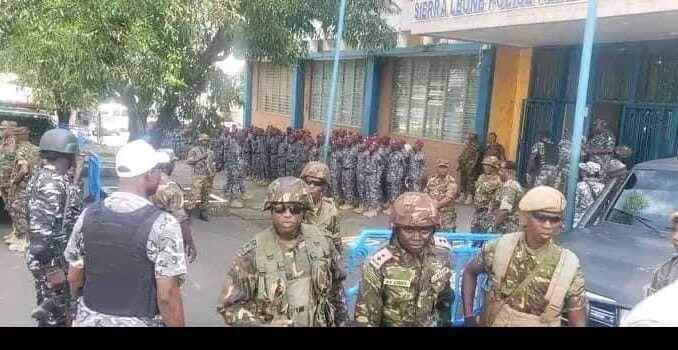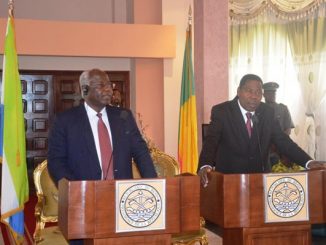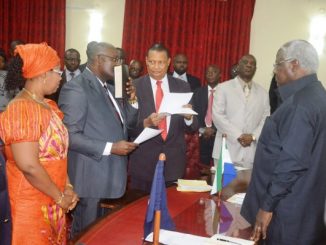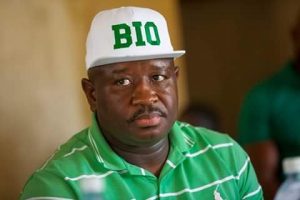
Why is Sierra Leone, which has been recognised as a model for successful postwar liberal peace and neoliberal development in Africa, experiencing repeated episodes of political violence? What does this trend of political violence, more prevalent at the local level, tell us about the country’s postwar peacebuilding and reconstruction strategy?
Mohamed Sesay warns that this upsurge in political violence is laying bare the myth that Sierra Leone is a post-conflict country on a linear trajectory toward democratic peace consolidation. Not only are the structural and social conditions that induce conflict still unresolved, most post-war reform interventions and institutions have unfortunately been captured or manipulated by the political elites as tools for political competition and power rather than for transforming those conditions.
On 10th August 2022, a violent protest broke out in the capital Freetown and some major towns in the Northern region. Although there were reports on social media about an imminent demonstration over rising cost of living in the country, almost everybody was shocked and surprised by the heinous brutality resulting in the gruesome death of six police personnel and 21 civilians and the wanton destruction of public properties .
One Sierra Leonean good governance and human rights campaigner lamented that what happened on 10th August “is not the Sierra Leone” that had long decided “never again to settle scores through violence.” She wanted the world to know that the brutal images they saw were not the Sierra Leone that has been on the “trajectory of democratic peace consolidation for 20 years.”
This depiction of the violence as a startling and senseless episodic eruption has been repeated several times in consultative meetings with traditional authorities, the inter-religious council, civil society organisations, and other national stakeholders . Whereas such reprehensible violence must horrify all of us, the political conflict and violence that precipitated this unrest is hardly confounding. Instead of dealing with this violent unrest as a surprising act of brutality, it must be understood as the latest and loudest wakeup call to Sierra Leoneans and international peacebuilders that the country’s political stability and peace is premised upon a weak, if not flawed, structural and socioeconomic foundation.
The myth of postconflict Sierra Leone
Few years into the attainment of formal independence from British colonial rule, Sierra Leone experienced one-party dictatorship over the span of two decades (1968-1992) and a decade-long civil war (1991-2002). Therefore, it is no mean feat that Sierra Leone has conducted three post-war national elections (two resulting in the transfer of power from the incumbent party to its main opposition), instituted transitional justice mechanisms to hold some warring leaders accountable and promote reconciliation , attracted foreign investments that produced one of the fastest growing economies at the beginning of the last decade , and gained a reputation from the UN and Western partners as a model for successful international peacekeeping and peacebuilding in the last 20 years. There is no question that since 2002, when the civil war was declared officially over, Sierra Leone has remained far more politically stable and peaceful than in the prewar and war years. Some progressive efforts have also been made to build new institutions expected to consolidate the peace and promote socioeconomic development .
Instead of dealing with this violent unrest as a surprising act of brutality, it must be understood as the latest and loudest wakeup call to Sierra Leoneans and international peacebuilders that the country’s political stability and peace is premised upon a weak, if not flawed, structural and socioeconomic foundation.
At the same time, it is a worrisome myth to assume from these relative successes that Sierra Leone is a post-conflict country. Although the civil war came to an end in 2002, political conflict and violence have continued unabated, often at a localised scale that go unnoticed by the outside world. In fact, political violence (including communal violence against transnational companies and local elites, riots and protests over national issues, state-sponsored violence, electoral violence, and other violent political competitions) has been on a steady upward trajectory in the last few years .
In this recent study by ACLED and others , it is reported that Sierra Leone experienced about 450 acts of political violence between 2016 and 2020, a trend that peaked following the 2018 general elections. Sierra Leone stands out in the West African sub-region for experiencing one of the highest levels of peacetime political disorder per capita , even though its political violence tends to be less deadly. In the same year, Afrobarometer reports that 80% of Sierra Leoneans recently surveyed viewed politics as a violent process while half of them admitted to have experienced electoral violence themselves. Even if we refocus attention on the country’s peace metrics, some of the recent results indicate some reversal of gains previously made. For example, the 2021 Global Peace Index has recorded a significant drop in Sierra Leone’s level of peacefulness and political stability in the last few years just as Freedom House considers the country as only partly free in the same year.
It is a worrisome myth to assume from these relative successes that Sierra Leone is a post-conflict country. Although the civil war came to an end in 2002, political conflict and violence have continued unabated, often at a localised scale that go unnoticed by the outside world.
Thus, August 10th is only the latest and perhaps most spectacular manifestation of political violence in post-war Sierra Leone. In addition to the gruesome death of civilians and police officers, the violence brought the commercial capital to a halt and forced the government to declare a nationwide state of emergency and curfew with almost immediate effect.
In a BBC interview and address to the nation , President Julius Maada Bio described the protesters as “local terrorists and insurrectionists” who, together with their collaborators and sponsors, would face the full force of the law. The official narrative is that the unrest was incited and orchestrated by political opponents in Sierra Leone and the diaspora who used social media to mobilise young people against the government . Such a law-and-order approach, which is usually based on the demonization and criminalisation of unauthorised protests, requires the deployment of the coercive and punitive apparatuses of the state which may in turn lead to the reproduction of political violence. However, I would like to stress that rather than treating August 10th as an unusual fateful day in post-war Sierra Leone, it must be viewed as a serious warning that the following structural, socioeconomic, and political conditions for peace need urgent attention. Looking at the shortcomings of the decolonisation process and post-war peacebuilding agendas helps us understand the root causes and why they remain unaddressed.
Missed opportunities for structural transformation
It must be noted that British colonialism in Sierra Leone was essentially about establishing structures, which constitute unequal relations of power, to exercise hegemonic control over society and extract its resources for the disproportionate benefit of those connected to power. While the Westphalian state model was forcefully imposed at the central level, the institution of chieftaincy was reinvented in its most autocratic form at the local level. With the alignment of elite interests between the central and local structures of governance, the logic of rule was one geared toward meeting the needs of the ruling class at the expense of the masses. Whatever forms of accountability the precolonial traditional and Western models of governance had was eliminated or compromised by alternative means of staying in power including most prominently patron-client relationships. The colonial capitalist economy was likewise structured to disproportionately benefit the few individuals in power while exploiting ordinary people’s labour and resources for production. At the societal level, the impoverishment of the population and their politicised polarisation along ethno-regional lines became the basis for exclusionary politics as well as patronage distribution of public resources.
Since Sierra Leone’s independence was a product of elite negotiations within the existing institutional structures, the Sierra Leonean ruling class that took over state governance had very little incentive to transform the logic of power and accumulation that had served the colonial administration and it local allies so well. From the regime of the Second Prime Minister Albert Margai to the long dictatorship of President Siaka Stevens and military juntas, this colonial mode of governance was optimally utilised more so by the two dominant political parties (the ruling Sierra Leone People’s Party and the main opposition All People’s Congress), accentuating political ethno-regional polarisation in the post-colonial period. As this ethno-regional politics benefited mostly the top elites and their close loyalists, it also reproduced an oppressor / oppressed dichotomy that is fundamentally about unequal access to resources and opportunities.
The oppressed class, which includes the poor, disadvantaged women, people with disabilities, the working class, rural peasants, urban hustlers, unemployed youth, and those impoverished by the war, is a heterogenous group united by a social condition characterised by lack of equal economic opportunity, restricted political representation, and denial of social mobilisation. The colonial-style structures that (re)produce this oppressed class also preserve and guarantee self-serving elite interests while being mostly responsible for the pervasiveness of political violence. While the elites are unwilling to create equal opportunities, political violence is produced either in the process of suppressing the revolt of the oppressed or in using its vulnerable members to acquire, contest, and consolidate power.
The colonial-style structures that (re)produce this oppressed class also preserve and guarantee self-serving elite interests while being mostly responsible for the pervasiveness of political violence.
Whether it was an agrarian rebellion against traditional authority, urban-based youth revolt against the central government, or collapse of the corrupt and unjust patronage system, the unbearable injustice and social effects of colonial-style governance and politics produced the civil war as the Truth and Reconciliation Commission report documents. However, the peace process and postwar reform strategy missed the opportunity to develop a transformative political plan for a more equitable Sierra Leone in the following respects:
Firstly, in the understandable quest to restore political stability and predictable order, the historical structural sources of mass grievance received little attention in the war-to-peace agenda. Expecting that positive peace would eventually follow political stability, democratic elections, and economic growth, reformers failed to confront structural issues of inequality and social injustice head-on. That some of the young people on August 10th were chanting “we want peace” 20 years after the war illustrates that Sierra Leoneans are still looking for social transformation beyond what liberal peace and neoliberal development can offer.
Secondly, even where post-war reforms (driven most prominently by the United Nations, international financial institutions, and Sierra Leone’s former colonial power, the UK ) are well intentioned, they have proved not only unable to transform social conditions but also helped inadvertently to restore the same logic of power and accumulation that is historically responsible for political violence. This concern about post-war reforms inadvertently creating a return to pre-war conditions was raised by some critical scholars at the very beginning of international peacebuilding interventions . The ACLED report goes further to note that the drivers of political violence include the very formal and informal government institutions—like political parties, local councils, police, and chieftaincy—which were restored to promote inclusive governance and peace. The report reminds policymakers that reform is often manipulated and transformed and can therefore lead to violence and instability .
Even where post-war reforms (driven most prominently by the United Nations, international financial institutions, and Sierra Leone’s former colonial power, the UK ) are well intentioned, they have proved not only unable to transform social conditions but also helped inadvertently to restore the same logic of power and accumulation that is historically responsible for political violence.
Beyond restoration to post-conflict peacebuilding
Therefore, rather than focusing attention only on restoring the country on the path of post-conflict stability, the August 10th crisis should occasion a deep reflection by Sierra Leoneans and international partners about the kind of peace we are building and who is benefiting from post-war reforms. Acknowledging that these are complex normative and practical questions that cannot be fully examined here, I am focusing only on governance and economic reforms which are central to my concerns.
In terms of governance, we must keep in mind that colonialism and post-war reforms denied Sierra Leone an opportunity to autonomously develop its political and socioeconomic systems outside external influence, a historical advantage that Europe had in evolving its institutional frameworks from absolute monarchy to liberal democracy and from feudalism to capitalism. Consequently, the institutional models for reorganising power and social order in Sierra Leone have always been fashioned elsewhere, often based on the Euro-American paradigm.
The problem then becomes not whether the new governance framework can effectively deliver what it promises but that the pre-existing structure and logic of power position certain actors to use new institutions and models for purposes and objectives other than those intended by (external) reformers. What this means is that reformers must go beyond predetermined purposes of reform to asking what they do on the ground, who they serve, and what outcomes they produce. From central to local governance systems, the fundamental questions remain how to decouple governance from the narrow interests of political elites, especially when their survival conflicts with accountable governance and the welfare of people.
With regards to socioeconomic conditions, it must also be noted that the current global crises linked to Covid-19 and the Russia/Ukraine war only worsened the precarious plight of the poor and socially marginalised in Sierra Leone. Even amid the post-war economic boom (largely from foreign direct investments in the extractive sector between 2007 and 2014), the country remained at the very bottom of the UN Human Development Index with dire social and health infrastructure resulting in catastrophic losses during the 2014/2015 Ebola outbreak.
From central to local governance systems, the fundamental questions remain how to decouple governance from the narrow interests of political elites, especially when their survival conflicts with accountable governance and the welfare of people.
This inability to transform the lives of the majority of Sierra Leoneans stems from the very structure of the political economy as well as the reintroduction of a socially insensitive neoliberal development model. Although an alternative to the statist and clientelist models adopted during the pre-war years, the post-war neoliberal model equally lacks any social justice mechanism to ensure equitable distribution of wealth in society. In addition to maintaining an economic structure that meaningfully absorbs only a tiny percentage of the workforce, its capitalist logic (re)produces a powerful class whose profit depends on the impoverishment of people. So, the question is not how to transform the economy from a statist or clientelist system to a market-oriented one but how to place the welfare and needs of the people at the economic center as a matter of justice.
In short, this is the larger political and socioeconomic context in which the August 10th unrest must be understood and addressed. As we condemn the reprehensible act of violence which took place on that day, we must remember that it did not take place in a social and political vacuum, nor isolated from repeated cases of post-war political violence in Sierra Leone. Those who came out of their homes on August 10th are mostly members of the oppressed class who are easily mobilised because of the abject social conditions they find themselves. To transcend violent political conflict in Sierra Leone requires an agenda of social and structural transformation of the very polity bequeathed by the British colonial administration into one based on genuine social cohesion, inclusive politics, and equitable distribution of resources.
A special thanks to Simeon Koroma, Evelyn Pauls and Nicky Armstrong for their comments on the draft article.
About the author:
Mohamed Sesay is an Assistant Professor in the Department of Social Science, York University and a UKRI Visiting Fellow at the LSE Centre for Women, Peace and Security where he is affiliated as a co-investigator/researcher in the Gender, Justice and Security Hub. His research interests are in transitional justice, international criminal justice, rule of law, customary justice, peacebuilding, and post-conflict reconstruction particularly in sub-Saharan Africa. On the Hub, Mohamed (with Simeon Koroma, Timap for Justice) is undertaking a study on land policy, gender justice, and plural legal systems in Sierra Leone.



